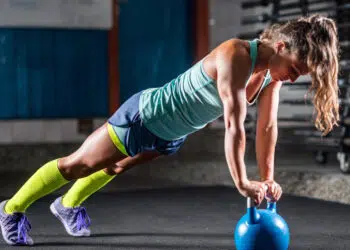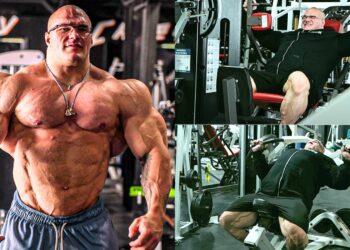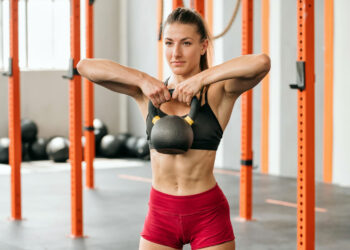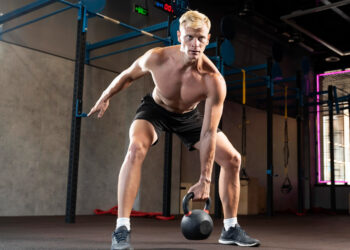Kettlebell training is one of the best ways to build muscle, develop functional strength, keep fit, and mix up your typical resistance training regime. In addition, it’s an effective way to train for improving movement patterns and ensuring equal weight distribution during certain exercises.
The kettlebell design is much different than a barbell or dumbbell as is very obvious. As a result, it allows you to do things you couldn’t (more efficiently) with either of the aforementioned fitness tools.
So today, we have 12 different ‘must-do‘ kettlebell exercises if you want to get the best results possible.
12 Best Kettlebell Exercises
- Kettlebell Swing
- Kettlebell Deadlift
- Kettlebell Goblet Squat
- Kettlebell Hang Clean
- Kettlebell Push Press
- Kettlebell Clean and Press
- Kettlebell Snatch
- Kettlebell Renegade Row
- Kettlebell Windmill
- Kettlebell Farmer’s Carry
- Kettlebell Turkish Get-up
- Kettlebell Suitcase Deadlift
1. Kettlebell Swing
The kettlebell swing is one of the most widely utilized exercises with a kettlebell. It works the entire posterior chain (backside of the body) and core muscles too. Plus, you’ll burn a load of calories at the same time which means you can burn fat if everything else is in check.
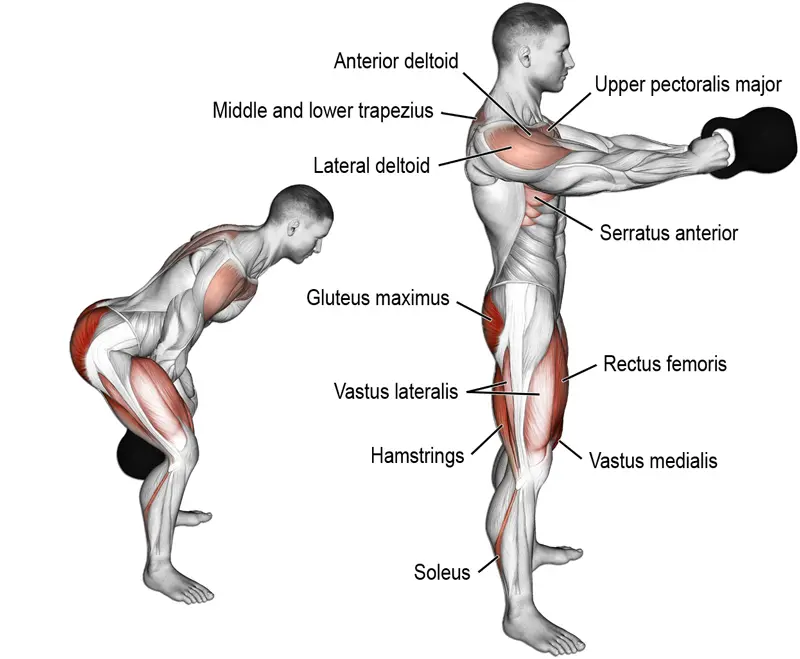
Something important to know about this movement is that the hips should be responsible for the arm action. So, rather than pulling/swinging the weight up, rely on the power of the hip movement to do that.
The kettlebell swing is a simple movement that everyone should incorporate if training with a kettlebell. You can do this exercise using one or two arms.
Level Up Your Fitness: Join our 💪 strong community in Fitness Volt Newsletter. Get daily inspiration, expert-backed workouts, nutrition tips, the latest in strength sports, and the support you need to reach your goals. Subscribe for free!
To do it:
- Place the kettlebell on the floor in front of you.
- Keep your feet slightly wider than hip-width and bend your knees a quarter of the way.
- Tighten your core, keep your shoulders down, straighten your back, then hinge forward at the hips without bending your knees further. Grip the kettlebell with two hands.
- With your torso parallel to the floor, flex your lats and lock in your rear delts. Keep your arms close to your body.
- Swing the kettlebell back between your legs then thrust your hips forward into the standing position which should move your arms upward in front of you.
You can also do this movement using both arms.
2. Kettlebell Deadlift
The kettlebell deadlift is another excellent posterior chain exercise that works the upper legs, back, core, and even biceps. Now, you won’t be able to pull gravity-defying pounds with this variation. But depending on your experience level, and goal/s, it has its place in a kettlebell workout.
To do it:
- Place the kettlebell on the floor directly in front of you.
- Stand close to the kettlebell, keep your back straight and core tight.
- Hinge forward at the hips and bend your knees then grab the kettlebell with both hands. Your upper legs should be slightly higher than parallel to the floor.
- Flex your lats, retract your shoulder blades and drive the weight up through your heels and midfoot.
- When the kettlebell reaches mid-thigh, push your hips forward to finish off the movement. Keep the kettlebell close to your body throughout the movement.
Feel free to do these using one arm at a time.
3. Kettlebell Goblet Squat
The goblet squat is a great kettlebell exercise for working your quads, hamstrings, and glutes. But it also works your core and forces you into thoracic extension which is ideal for good lifting posture. But why is lifting posture so important? Having good lifting posture will allow you to lift the most weight possible, it’ll strengthen your upper posterior muscles, and prevent thoracic outlet syndrome which is not good.
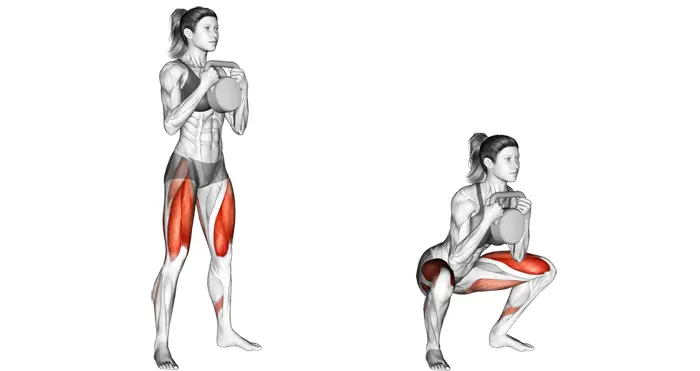
Thoracic outlet syndrome is when the space between the collarbone and the first rib is compressed. This can result in pain in the shoulder and neck plus numbness in the fingers. Then you’re looking at possibly worse issues.
So, lifting weights with bad posture is something that must be corrected immediately!
To do it:
- Stand with your feet wider than hip-width and pointed slightly outward.
- Hold the kettlebell upside down against your chest, keeping your shoulders back and chest up.
- Squat down to just below parallel or right at parallel.
- Drive through your heels and midfoot back into a standing position.
You can also do lunges in this position for better isolation of each leg.
4. Kettlebell Hang Clean
The kettlebell hang clean is one of the best power movements you can do for your upper body. But the way many people do it while using a kettlebell is a recipe for injury. They’ll hold the kettlebell with a barbell grip in the hand (should be an angled grip) then simply flip the bulk of the kettlebell directly over.
As a result, the weights smacks into the forearm muscles (not good), not to mention placing a lot of stress on the wrists. Doing the kettlebell clean incorrectly also positions the upper arm in a compromising position. Then the elbows and shoulders begin to suffer as well.
So, the key to doing this exercise safely is to keep the kettlebell close to your body, while using a grip that’ll allow the weight to move around the handle as opposed to flipping over it. The right way to do this is to rotate the wrist during the concentric (positive) portion of the exercise. This is also important for achieving the ideal point of contact with the kettlebell.
You also want to keep the kettlebell somewhat loose and not completely rigid in your hand. This will allow you to effectively move the kettlebell around your wrist most efficiently. Lastly, you don’t want to keep your wrists completely straight or flexed, but in slight extension for better control.
Level Up Your Fitness: Join our 💪 strong community in Fitness Volt Newsletter. Get daily inspiration, expert-backed workouts, nutrition tips, the latest in strength sports, and the support you need to reach your goals. Subscribe for free!
To do it:
- Grip the kettlebell so that the handle is at a more diagonal angle in your palm rather than straight across (e.g. the handle should start high near the thumb and angle down to the bottom of the wrist directly under the pinky finger).
- Bring the kettlebell back as if you were doing a swing while bending your knees slightly.
- Thrust upward and pull the kettlebell up the center of your body as if you were zipping up your jacket then rotate your wrist so your palm is facing away from you. Your forearms should be mostly straight only at a slight angle toward the midline of your torso. You want the kettlebell to land softly between your forearm and bicep.
- Reverse the motion and repeat.
You can also do these using two kettlebells.
5. Kettlebell Push Press
The push press is a simple movement that works the shoulders and traps plus it also involves assistance from the triceps. Your core will also help to stabilize the weight being pressed overhead. But the little ‘push’ from the legs helps to get heavier poundages overhead and it’s also useful when fatigued.
To do it:
- Do a clean to getthe kettlebell in the racked position, bend your knees, and then straighten your legs while pressing the kettlebell overhead. Your wrist should be straight.
- Lower the weight to your shoulder and press it again for desired reps.
* You can do both arms at the same time for more of a challenge.
6. Kettlebell Clean and Press
So for this variation, you’re going to combine the two previous movements to make for one fluid motion. Except you won’t do the ‘push’ part. It’s a great exercise for developing overhead strength, power, and shoulder stability.
To do it:
- Clean the weight from the floor or a standing position.
- Take a second and then press the weight overhead.
* Try two kettlebells if you’re more advanced.
7. Kettlebell Snatch
The snatch involves bringing the kettlebell overhead from the swing position. So, your whole kinetic chain must function and move optimally together for this to happen. During the swing upward, you want to make sure to keep your arm as close to your body as possible so there is no space until you bring your arm overhead.
To do it:
- Begin in a standing position while holding the kettlebell in front of your body. Make sure the kettlebell handle is at an angle against your palm.
- With your back straight and core tight, bend your knees a quarter of the way down to allow the kettlebell to lower while hinging at the hips. Allow no space between your arm and body. This part of the movement is similar to the kettlebell swing.
- Thrust the hips upward and bring the kettlebell up the body and not away from it. So when it’s time to raise the arm overhead, keep your elbow high and outside to keep your arm close.
- When you raise the kettlebell overhead, you can rotate your wrist for a soft landing of the kettlebell on your wrist, or the catch.
8. Kettlebell Renegade Row
The renegade row is a great exercise for working the back muscles plus the biceps are assisting muscles and your core is challenged due to the position. It does require a little balance though but it’s a good functional movement.
To do it:
- Get into a push-up position and grip the kettlebell handles so your hands are about shoulder-width apart and on either side of your lower chest.
- Keep your torso neutral and row one kettlebell by pulling it up toward your ribcage.
- Place it back on the floor and repeat on the other side.
9. Kettlebell Windmill
The kettlebell windmill is a great core and hip flexibility exercise and it may also benefit the spine. You will need a little shoulder flexibility too but if you’re more advanced you can definitely benefit from this unique movement.
To do it:
- Hold the kettlebell in one hand overhead.
- Position your feet at about a 45-degree angle in the opposite direction of the kettlebell.
- Soften your knees but don’t allow them to bend further during the movement.
- Maintain a neutral spine and bend your torso in the same direction as your feet while looking at the kettlebell. Your non-working arm should mirror the arm extended overhead by keeping it extended and down by your leg.
- Push upward through your heels and midfoot while squeezing your glutes as you return to the starting position.
- Repeat on the other side after you’ve completed the desired number of reps.
10. Kettlebell Farmer’s Carry
The Farmer’s carry improves full-body stability and conditioning, plus it improves lifting posture, grip strength, and even mental fortitude. It does work pretty much all of the muscles that the deadlift does but to a lesser degree. However, the additional benefits make it more ideal for functional training.
If you’re familiar with Strongman events, then you’re probably familiar with the farmer’s carry.
It’s a rather simple movement that involves picking up the weight, keeping everything tight with shoulders back, and walking for distance without breaking form. Set a timer or just walk holding two kettlebells until you can’t.
11. Kettlebell Turkish Get-up
If you’re ready for a challenge, the Turkish get-up might be the perfect movement for you. It’s a very functional movement that can improve stability, shoulder health, coordination, and overall full-body awareness, as you have to hold a kettlebell overhead while going from a lying to a standing position.
Here’s a great video demonstration…
12. Kettlebell Suitcase Deadlift
A lot of exercises focus on anterior and posterior stability/strength. However, if we’re to prevent energy leaks and maximize overall physical performance, then we need to do exercises that focus on lateral function. And any variation of the suitcase deadlift will do this extremely well.
So since we’re talking about kettlebell exercises, what better time to offer this is as a great variation.
To do it:
- Stand next to the kettlebell with feet about hip-width apart.
- Bend your hips and knees until you can grab the kettlebell while keeping your back flat. Your upper legs should be above parallel to the floor.
- Drive upward through your heels and midfoot then thrust your hips forward as the kettlebell reaches mid-thigh. Make sure your torso and shoulders are level and resist the kettlebell pulling you to one side.
Choosing a weight
Before you start your training, it’s a good idea to know how much weight is most optimal for you. Now, if you’re an intermediate lifter or more advanced then you likely know a good weight for you. But for those new to training, choose a weight that you can comfortably lift without straining.
If you can’t maintain proper form or perform more than 8 reps, the weight is probably too heavy for you at this point in your training. So, opt for a weight that allows for a challenge once you reach the 10-12 rep range. The most important thing is that you learn the exercise first and the weight will naturally follow.
FAQs
Can you build muscle using kettlebells?
If you’re using enough resistance while continually progressing in weight or reps then you’ll build muscle. The exercises should be challenging and you should not be able to perform endless reps.
We recommend keeping the weight in the 10-20 rep range for muscle building.
What are the best kettlebell exercises for building muscle and strength?
There are several very effective kettlebell exercises that will help to build muscle and strength.
For example, some of the most common kettlebell exercises are…
- Kettlebell swings
- Kettlebell deadlifts
- Kettlebell press
- Kettlebell snatch
- Kettlebell clean
- Kettlebell farmer’s carry
Are kettlebells safe for everyone to use?
Kettlebells are better suited for individuals who have a decent amount of training experience unless doing very basic movements.
Otherwise, you can get injured as the kettlebell is a bit different than a dumbbell or barbell.
Are kettlebells a good alternative to dumbbell and barbell training?
It depends entirely on your goals. You won’t be able to lift as much weight using a kettlebell as you would a dumbbell or barbell. So if your goal is maximum muscle growth and strength, then you’ll need to focus more on dumbbell and barbell training.
However, kettlebells are a great addition because of the more functional benefits. Although, kettlebell training can produce muscle and strength gains with an effective routine.
Wrapping Up
We hope you enjoyed these 12 very effective kettlebell exercises/movements. Each provides its own benefits and you’d be unlikely to find much better when it comes to the effectiveness of kettlebell training. Some are easier while others are more challenging but just start slow, learn the techniques, and you’ll have an arsenal of kettlebell exercises that you can pull from at any time.



